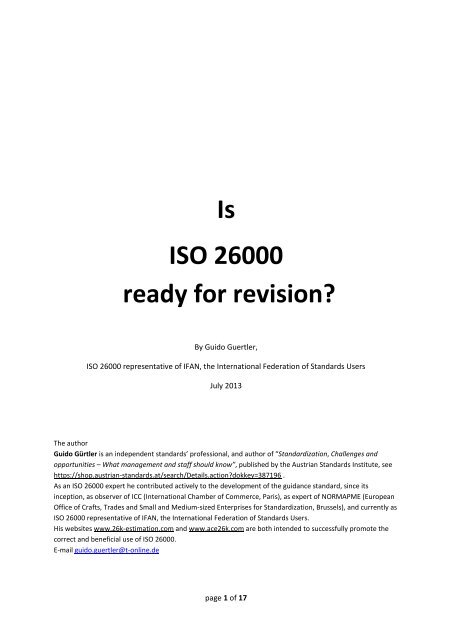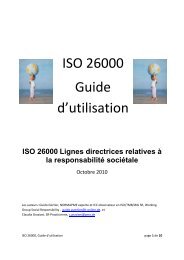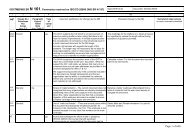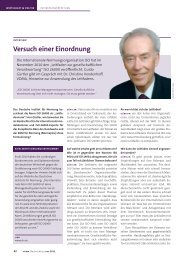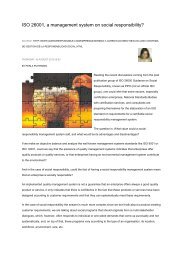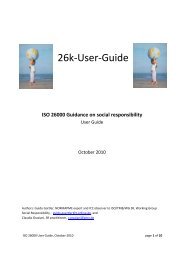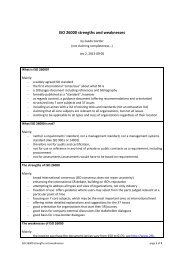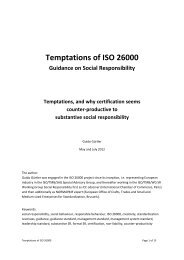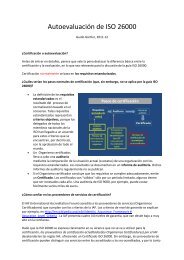download in PDF format - ISO 26000, an estimation
download in PDF format - ISO 26000, an estimation
download in PDF format - ISO 26000, an estimation
Create successful ePaper yourself
Turn your PDF publications into a flip-book with our unique Google optimized e-Paper software.
Is<br />
<strong>ISO</strong> <strong>26000</strong><br />
ready for revision<br />
By Guido Guertler,<br />
<strong>ISO</strong> <strong>26000</strong> representative of IFAN, the International Federation of St<strong>an</strong>dards Users<br />
July 2013<br />
The author<br />
Guido Gürtler is <strong>an</strong> <strong>in</strong>dependent st<strong>an</strong>dards’ professional, <strong>an</strong>d author of “St<strong>an</strong>dardization, Challenges <strong>an</strong>d<br />
opportunities – What m<strong>an</strong>agement <strong>an</strong>d staff should know”, published by the Austri<strong>an</strong> St<strong>an</strong>dards Institute, see<br />
https://shop.austri<strong>an</strong>-st<strong>an</strong>dards.at/search/Details.actiondokkey=387196 .<br />
As <strong>an</strong> <strong>ISO</strong> <strong>26000</strong> expert he contributed actively to the development of the guid<strong>an</strong>ce st<strong>an</strong>dard, s<strong>in</strong>ce its<br />
<strong>in</strong>ception, as observer of ICC (International Chamber of Commerce, Paris), as expert of NORMAPME (Europe<strong>an</strong><br />
Office of Crafts, Trades <strong>an</strong>d Small <strong>an</strong>d Medium-sized Enterprises for St<strong>an</strong>dardization, Brussels), <strong>an</strong>d currently as<br />
<strong>ISO</strong> <strong>26000</strong> representative of IFAN, the International Federation of St<strong>an</strong>dards Users.<br />
His websites www.26k-<strong>estimation</strong>.com <strong>an</strong>d www.ace26k.com are both <strong>in</strong>tended to successfully promote the<br />
correct <strong>an</strong>d beneficial use of <strong>ISO</strong> <strong>26000</strong>.<br />
E-mail guido.guertler@t-onl<strong>in</strong>e.de<br />
page 1 of 17
Contents<br />
Introduction............................................................................................................................................. 3<br />
1 Appreciation .................................................................................................................................... 3<br />
2 <strong>ISO</strong> <strong>26000</strong>:2010 <strong>in</strong> figures ............................................................................................................... 4<br />
3 How <strong>an</strong> “<strong>ISO</strong> systematic review” works, <strong>in</strong> pr<strong>in</strong>ciple ...................................................................... 5<br />
4 Observations.................................................................................................................................... 5<br />
4.1 Other codes <strong>an</strong>d st<strong>an</strong>dards ..................................................................................................... 5<br />
4.2 SR regulation <strong>an</strong>d <strong>ISO</strong> <strong>26000</strong> ................................................................................................... 6<br />
4.3 Tools ........................................................................................................................................ 6<br />
4.4 User guides <strong>an</strong>d other literature ............................................................................................. 7<br />
4.5 Misuse of <strong>ISO</strong> <strong>26000</strong>................................................................................................................ 7<br />
4.6 Use by <strong>in</strong>volved org<strong>an</strong>izations................................................................................................. 8<br />
4.7 Project costs ............................................................................................................................ 8<br />
5 Features suggested to ma<strong>in</strong>ta<strong>in</strong>...................................................................................................... 9<br />
5.1 Guid<strong>an</strong>ce.................................................................................................................................. 9<br />
5.2 Freedom of use........................................................................................................................ 9<br />
5.3 Autonomy of use ................................................................................................................... 10<br />
6 Features suggested to ch<strong>an</strong>ge....................................................................................................... 10<br />
6.1 Base revision on more experience ........................................................................................ 10<br />
6.2 Put more emphasis on the WHY ........................................................................................... 11<br />
6.3 Reduce content <strong>an</strong>d volume ................................................................................................. 11<br />
6.4 Modify the all-encompass<strong>in</strong>g claim....................................................................................... 12<br />
6.5 Neutralize <strong>in</strong>dustry bias......................................................................................................... 12<br />
6.6 Overcome l<strong>an</strong>guage <strong>an</strong>d def<strong>in</strong>ition problems....................................................................... 12<br />
6.7 New pric<strong>in</strong>g............................................................................................................................ 13<br />
7 Develop a safer future-oriented version....................................................................................... 14<br />
7.1 Base <strong>ISO</strong> <strong>26000</strong>:20xx on a globally agreed set of societal values ......................................... 14<br />
7.2 Take trends <strong>in</strong>to account....................................................................................................... 15<br />
7.3 Structure of a future <strong>ISO</strong> <strong>26000</strong>:20xx.................................................................................... 16<br />
7.4 Time l<strong>in</strong>e for <strong>ISO</strong> <strong>26000</strong>:20xx................................................................................................. 16<br />
8 Conclusion ..................................................................................................................................... 17<br />
page 2 of 17
Introduction<br />
A “st<strong>an</strong>dard” accord<strong>in</strong>g to <strong>ISO</strong>/IEC Guide 2:1996 is def<strong>in</strong>ed as ‘A document established by<br />
consensus <strong>an</strong>d approved by a recognized body that provides for common <strong>an</strong>d repeated<br />
use, rules, guidel<strong>in</strong>es or characteristics for activities or their results, aimed at the<br />
achievement of the optimum degree of order <strong>in</strong> a given context’. Generally, st<strong>an</strong>dards are<br />
understood as conta<strong>in</strong><strong>in</strong>g normative requirements which one has to fulfill <strong>in</strong> order to conform to<br />
those requirements.<br />
<strong>ISO</strong> <strong>26000</strong> “Guid<strong>an</strong>ce on Social Responsibility” is not such a typical normative st<strong>an</strong>dard, it offers<br />
guid<strong>an</strong>ce <strong>an</strong>d this dist<strong>in</strong>ction makes a world of difference. This guid<strong>an</strong>ce is expressed <strong>in</strong> the form of<br />
recommendations, proposals, advice, <strong>an</strong>d orientation. For a possible revision of <strong>ISO</strong> <strong>26000</strong>:2010 (that<br />
me<strong>an</strong>s the edition approved/published <strong>in</strong> 2010), some major aspects shall be highlighted. This may<br />
be of particular <strong>in</strong>terest <strong>an</strong>d usefulness to<br />
- All engaged <strong>in</strong> improv<strong>in</strong>g their personal or their org<strong>an</strong>ization’s social responsibility,<br />
- <strong>ISO</strong> <strong>26000</strong> users,<br />
- Users of other social responsibility related codes <strong>an</strong>d st<strong>an</strong>dards, <strong>an</strong>d<br />
- Members of <strong>ISO</strong> <strong>26000</strong> st<strong>an</strong>dardization committees <strong>in</strong>volved <strong>in</strong> the “<strong>ISO</strong> systematic review”<br />
process which is scheduled to start <strong>in</strong> October 2013.<br />
The bottom l<strong>in</strong>e is:<br />
1. With all its strengths <strong>an</strong>d weaknesses (http://www.26k<strong>estimation</strong>.com/html/strengths___weaknesses_of_iso_.html)<br />
<strong>ISO</strong> <strong>26000</strong>:2010 is a<br />
good achievement, given the circumst<strong>an</strong>ces under which it was developed, but it is<br />
not good enough to be applicable as broadly as <strong>in</strong>tended.<br />
2. Nevertheless, <strong>ISO</strong> <strong>26000</strong>:2010 should be opened for review only, if subst<strong>an</strong>tial<br />
improvements <strong>in</strong> regard of document content <strong>an</strong>d project m<strong>an</strong>agement seem to<br />
be achievable.<br />
Incremental improvements will not have merit, particularly not <strong>in</strong> view of the<br />
foreseeable project costs.<br />
1 Appreciation<br />
Develop<strong>in</strong>g a st<strong>an</strong>dard on social responsibility has been <strong>an</strong> experiment for <strong>ISO</strong>. It started <strong>in</strong> 2002 with<br />
the setup of a fact-f<strong>in</strong>d<strong>in</strong>g committee, called SAG (Special Advisory Group to the <strong>ISO</strong>/TMB - Technical<br />
M<strong>an</strong>agement Board). The development time took almost 6 years <strong>an</strong>d ended with the Stockholm<br />
conference mid-2004 when results were presented to the general public.<br />
With some 450 representatives, this <strong>ISO</strong> work<strong>in</strong>g group was to date the largest work<strong>in</strong>g group ever<br />
<strong>an</strong>d required skilled m<strong>an</strong>agement. ABNT <strong>an</strong>d SIS, the Brazili<strong>an</strong> <strong>an</strong>d Swedish <strong>ISO</strong> member bodies, did a<br />
good job <strong>in</strong> tw<strong>in</strong>-lead<strong>in</strong>g this exceed<strong>in</strong>gly large “group”.<br />
<strong>ISO</strong> experimented with a so-called stakeholder approach, me<strong>an</strong><strong>in</strong>g that the content should be<br />
developed by representatives of identified stakeholder groups (<strong>in</strong>dustry, government, labour, NGOs,<br />
consumers, research <strong>an</strong>d services) who had to be nom<strong>in</strong>ated by <strong>ISO</strong> national member bodies <strong>an</strong>d <strong>ISO</strong><br />
D-Liaison org<strong>an</strong>izations like ICC (International Chamber of Commerce) or IOE (International<br />
page 3 of 17
Org<strong>an</strong>ization of Employers) <strong>an</strong>d multiple UN D-Liaisons, while f<strong>in</strong>al vot<strong>in</strong>g on the draft document was<br />
subject to exist<strong>in</strong>g <strong>ISO</strong> rules (one country, one-vote; no vote by stakeholder groups, no vote by D-<br />
Liaison org<strong>an</strong>izations).<br />
<strong>ISO</strong> national member bodies had been challenged to gather as m<strong>an</strong>y as possible stakeholder groups<br />
on their committees. In view of the experimental character of the whole project, it was not too much<br />
of a surprise that m<strong>an</strong>y (exactly 67,5% of all) national committees did not m<strong>an</strong>age to engage all<br />
stakeholder groups at that po<strong>in</strong>t <strong>in</strong> time; http://www.26k<strong>estimation</strong>.com/html/iso_<strong>an</strong>d_societal_st<strong>an</strong>dards.html#<strong>an</strong>alysis.<br />
The development phase was characterized by serious <strong>an</strong>d often tough negotiations of stakeholder<br />
<strong>in</strong>terests. <strong>ISO</strong> rules say that a project is not successful if more th<strong>an</strong> five Work<strong>in</strong>g Drafts are needed. In<br />
this case the solution was found to produce a WORKING DRAFT 4.1 <strong>an</strong>d 4.2 <strong>in</strong> order not to exceed<br />
the formal limit of 5 drafts.<br />
The published <strong>ISO</strong> <strong>26000</strong>:2010 is a good basis for <strong>in</strong>ternational orientation <strong>an</strong>d use. S<strong>in</strong>ce societies<br />
develop dynamically over time, have different traditions, cultures <strong>an</strong>d beliefs etc. <strong>an</strong>d w<strong>an</strong>t to<br />
ma<strong>in</strong>ta<strong>in</strong> such differences, it was a good decision to develop a guid<strong>an</strong>ce document <strong>an</strong>d not a<br />
guidel<strong>in</strong>e or a requirements’ st<strong>an</strong>dard.<br />
2 <strong>ISO</strong> <strong>26000</strong>:2010 <strong>in</strong> figures<br />
The result of the six year multi-stakeholder development process is a guid<strong>an</strong>ce document of the<br />
follow<strong>in</strong>g structure:<br />
- Clause 1: Introduction<br />
- Clause 2: Scope<br />
- Clause 3: Terms <strong>an</strong>d def<strong>in</strong>itions<br />
- Clause 4: Pr<strong>in</strong>ciples (accountability, tr<strong>an</strong>sparency, ethical behaviour as well as respect for<br />
stakeholder <strong>in</strong>terests, for the rule of law, for <strong>in</strong>ternational norms of behaviour, <strong>an</strong>d<br />
respect for hum<strong>an</strong> rights)<br />
- Clause 5: Recogniz<strong>in</strong>g social responsibility <strong>an</strong>d engag<strong>in</strong>g stakeholders<br />
- Clause 6: Guid<strong>an</strong>ce on social responsibility core subjects (org<strong>an</strong>izational govern<strong>an</strong>ce,<br />
hum<strong>an</strong> rights, Labour practices, the environment, fair operat<strong>in</strong>g practices, consumer<br />
issues, <strong>an</strong>d community <strong>in</strong>volvement <strong>an</strong>d development)<br />
- Clause 7: Guid<strong>an</strong>ce on <strong>in</strong>tegrat<strong>in</strong>g social responsibility throughout <strong>an</strong> org<strong>an</strong>ization.<br />
In figures: There are 7 pr<strong>in</strong>ciples (clause 4) <strong>an</strong>d 7 core subjects (clause 6); the core subjects are<br />
subdivided <strong>in</strong>to 37 issues; the whole document comprises a total of 484 recommendations (<strong>in</strong> all<br />
clauses, the author’s count).<br />
The subst<strong>an</strong>ce of these recommendations is good, however, it seems a detriment that the document<br />
is generally written <strong>in</strong> the form <strong>an</strong>d presentation of a textbook, not a st<strong>an</strong>dard (“good st<strong>an</strong>dards” do<br />
not conta<strong>in</strong> redund<strong>an</strong>cies). The volume <strong>in</strong> <strong>an</strong>d of itself (some 100 pages) is a real hurdle to start us<strong>in</strong>g<br />
<strong>ISO</strong> <strong>26000</strong>, particularly for smaller org<strong>an</strong>izations.<br />
page 4 of 17
3 How <strong>an</strong> “<strong>ISO</strong> systematic review” works, <strong>in</strong> pr<strong>in</strong>ciple<br />
Accord<strong>in</strong>g to <strong>ISO</strong> rules <strong>an</strong>d practices, each <strong>ISO</strong> st<strong>an</strong>dard should be evaluated every five years as to<br />
whether it needs to be revised or reaffirmed. This rule was established <strong>in</strong> order to ensure that<br />
technical st<strong>an</strong>dards keep track with technical development <strong>an</strong>d <strong>in</strong>novation. <strong>ISO</strong> <strong>26000</strong> is not a<br />
technical st<strong>an</strong>dard; however, it is subject to the same rules. As is common, “<strong>ISO</strong> systematic reviews”<br />
typically beg<strong>in</strong> two or so years prior to that five year cycle. So, the <strong>ISO</strong> <strong>26000</strong>:2010 “systematic<br />
review” may start <strong>in</strong> October 2013.<br />
<strong>ISO</strong> national member bodies will be asked for their op<strong>in</strong>ions on whether to withdraw, revise/amend<br />
or confirm/reaffirm the st<strong>an</strong>dard. Some further details are given at http://www.26k<strong>estimation</strong>.com/html/review_of_iso_<strong>26000</strong>_2010_.html.<br />
It will be <strong>in</strong>terest<strong>in</strong>g to see whether a<br />
possible set up project group will be composed like normal <strong>ISO</strong> committees by “national delegates”<br />
only or aga<strong>in</strong> additionally by representatives from D-Liaison org<strong>an</strong>izations.<br />
The result of the “systematic review” will be the decision on whether to revise <strong>ISO</strong> <strong>26000</strong>:2010 or<br />
not.<br />
4 Observations<br />
Observations on <strong>ISO</strong> <strong>26000</strong> c<strong>an</strong> never claim completeness because societies develop. There is <strong>an</strong><br />
unlimited variety of user situations: each us<strong>in</strong>g org<strong>an</strong>ization is specific, each society, <strong>an</strong>d each po<strong>in</strong>t<br />
<strong>in</strong> time of societal development, <strong>an</strong>d therefore each social responsibility situation.<br />
However, these various observations of facts may give quite a comprehensive picture <strong>an</strong>d may help<br />
pave the ground for the decision result<strong>in</strong>g from the systematic review process.<br />
4.1 Other codes <strong>an</strong>d st<strong>an</strong>dards<br />
When <strong>ISO</strong> <strong>26000</strong> was developed, social responsibility was practiced by corporations <strong>an</strong>d other types<br />
of org<strong>an</strong>izations, widely known as CSR. M<strong>an</strong>y codes <strong>an</strong>d st<strong>an</strong>dards existed already, at the national<br />
level by m<strong>an</strong>y trade associations <strong>an</strong>d at the global level by a variety of <strong>in</strong>ternational corporations <strong>an</strong>d<br />
org<strong>an</strong>izations. Some more import<strong>an</strong>t ones seem to be:<br />
- UNGC United Nations Global Compact http://www.unglobalcompact.org/ <strong>an</strong>d its ten pr<strong>in</strong>ciples<br />
http://www.unglobalcompact.org/AboutTheGC/TheTenPr<strong>in</strong>ciples/<strong>in</strong>dex.html<br />
- GRI Global Report<strong>in</strong>g Initiative https://www.globalreport<strong>in</strong>g.org/report<strong>in</strong>g/latest-guidel<strong>in</strong>es/g3-1-<br />
guidel<strong>in</strong>es/Pages/default.aspx<br />
- OECD Guidel<strong>in</strong>es for Mult<strong>in</strong>ational Enterprises,<br />
http://www.oecd.org/<strong>in</strong>vestment/<strong>in</strong>vestmentpolicy/48004323.pdf<br />
- ILO Tripartite Declaration of Pr<strong>in</strong>ciples Concern<strong>in</strong>g Mult<strong>in</strong>ational Enterprises <strong>an</strong>d Social Policy<br />
http://www.ilo.org/wcmsp5/groups/public/---ed_emp/---<br />
emp_ent/documents/publication/wcms_101234.pdf<br />
- ILO Declaration on Fundamental Pr<strong>in</strong>ciples <strong>an</strong>d Rights at Work<br />
http://www.ilo.org/wcmsp5/groups/public/---ed_norm/---<br />
relconf/documents/meet<strong>in</strong>gdocument/wcms_176149.pdf<br />
- UN Guid<strong>in</strong>g Pr<strong>in</strong>ciples for Hum<strong>an</strong> Rights <strong>an</strong>d Bus<strong>in</strong>ess<br />
http://www.unglobalcompact.org/issues/hum<strong>an</strong>_rights/The_UN_SRSG_<strong>an</strong>d_the_UN_Global_Compac<br />
t.html<br />
page 5 of 17
- An employer’s guide to the Guid<strong>in</strong>g Pr<strong>in</strong>ciples on Bus<strong>in</strong>ess <strong>an</strong>d Hum<strong>an</strong> Rights http://www.ioe-<br />
emp.org/fileadm<strong>in</strong>/user_upload/documents_pdf/policy_area/_2012-<br />
05__Updated_List_of_all_IOE_publications.pdf<br />
- Corporate Responsibility to Respect Hum<strong>an</strong> Rights - <strong>an</strong> <strong>in</strong>terpretive guide<br />
http://www.unglobalcompact.org/docs/issues_doc/hum<strong>an</strong>_rights/Resources/CR_Respect_HR_Interpr<br />
etive_Guide.pdf<br />
<strong>ISO</strong> <strong>26000</strong> added to this set <strong>an</strong>d <strong>in</strong> some way tried to gather the best from all. As regards<br />
representativeness, one c<strong>an</strong> consider <strong>ISO</strong> provid<strong>in</strong>g possibly the broadest <strong>an</strong>d most neutral basis. It<br />
seems to be <strong>in</strong>terest<strong>in</strong>g that the newly published GRI4 is reported not to mention <strong>ISO</strong> <strong>26000</strong>; one of<br />
the reasons could be that <strong>ISO</strong> <strong>26000</strong> is not for free, <strong>in</strong> contrast to the other documents listed here.<br />
4.2 SR regulation <strong>an</strong>d <strong>ISO</strong> <strong>26000</strong><br />
When <strong>ISO</strong> <strong>26000</strong> was developed, social responsibility related laws <strong>an</strong>d regulations already existed <strong>in</strong><br />
some way <strong>in</strong> most countries, surely with great differences <strong>in</strong> subst<strong>an</strong>ce <strong>an</strong>d <strong>in</strong> the level of detail due<br />
to signific<strong>an</strong>t differences <strong>in</strong> history <strong>an</strong>d evolution of economies. Major differences c<strong>an</strong> be seen<br />
between <strong>in</strong>dustrialized countries <strong>an</strong>d countries under development, but also among <strong>in</strong>dustrialized<br />
countries.<br />
The primary obligation of the state/government is to protect its citizens, their health, life, <strong>an</strong>d<br />
property. S<strong>in</strong>ce the beg<strong>in</strong>n<strong>in</strong>g of agrari<strong>an</strong> civilization <strong>an</strong>d various societies <strong>in</strong> the fertile crescent or<br />
meso-America, this <strong>in</strong>cluded the application of rules on how to live together. In former times such<br />
rules were just not called “social responsibility”.<br />
There are strong <strong>an</strong>d weak societies <strong>an</strong>d strong <strong>an</strong>d weak governments. M<strong>an</strong>y supporters of the <strong>ISO</strong><br />
<strong>26000</strong> project believed, <strong>an</strong>d still believe, that <strong>an</strong> <strong>in</strong>ternational st<strong>an</strong>dard could help compensate for<br />
the deficiencies of non-existent or weak national laws <strong>an</strong>d enforcement mech<strong>an</strong>isms. A friend of<br />
m<strong>in</strong>e <strong>in</strong> Spa<strong>in</strong> expressed it this way: “We c<strong>an</strong>’t wait until governments have completed laws <strong>an</strong>d<br />
regulation <strong>an</strong>d enforcement mech<strong>an</strong>isms…”. This <strong>in</strong>tent <strong>an</strong>d desire is more th<strong>an</strong> accepted. However,<br />
we also have to recognize that the private sector c<strong>an</strong> never substitute government action; this leads<br />
to two conclusions:<br />
- An <strong>ISO</strong> st<strong>an</strong>dard c<strong>an</strong> help to promote social responsibility awareness, but its effectiveness<br />
depends on exist<strong>in</strong>g cultures <strong>an</strong>d beliefs, laws <strong>an</strong>d regulations <strong>an</strong>d the practiced conviction of<br />
people to obey the law<br />
- A st<strong>an</strong>dard like <strong>ISO</strong> <strong>26000</strong> is more appreciated <strong>in</strong> countries without exist<strong>in</strong>g detailed socially<br />
responsibility related law or poor hum<strong>an</strong> rights perform<strong>an</strong>ce.<br />
4.3 Tools<br />
As mentioned, <strong>ISO</strong> <strong>26000</strong> offers guid<strong>an</strong>ce, i.e. recommendations, proposals, advice, <strong>an</strong>d orientation.<br />
Guid<strong>an</strong>ce c<strong>an</strong> of course be <strong>in</strong>dividually <strong>in</strong>terpreted. In contrast to normative st<strong>an</strong>dards, a guid<strong>an</strong>ce<br />
st<strong>an</strong>dard does not tell you how to use it; the m<strong>an</strong>ner of us<strong>in</strong>g it is totally left to you as the user. So, it<br />
is not a surprise that <strong>ISO</strong> <strong>26000</strong> c<strong>an</strong> be used <strong>in</strong> most different ways <strong>an</strong>d that a number of different<br />
tools came <strong>in</strong>to existence.<br />
At various <strong>in</strong>st<strong>an</strong>ces, particularly <strong>in</strong> clause 6, <strong>ISO</strong> <strong>26000</strong> expresses that all 7 core subjects are relev<strong>an</strong>t<br />
to all types <strong>an</strong>d sizes of org<strong>an</strong>izations, but not all 37 issues. Therefore, it is first of all more th<strong>an</strong><br />
crucial to reliably identify/select the relev<strong>an</strong>t <strong>ISO</strong> <strong>26000</strong> issues <strong>an</strong>d/or recommendations, where <strong>an</strong><br />
page 6 of 17
org<strong>an</strong>ization could take action towards the development of society. In this regard it seems to be<br />
worthwhile to search on the Internet e.g. for “<strong>ISO</strong> <strong>26000</strong> tool” to get <strong>an</strong> overview.<br />
Good tools follow this logic of selection <strong>an</strong>d put the question of <strong>an</strong> issue’s relev<strong>an</strong>ce <strong>in</strong>to the<br />
foreground. This is correct <strong>an</strong>d efficient.<br />
Other tools list all 37 issues <strong>an</strong>d their recommendations <strong>in</strong> order to more or less ask how your<br />
org<strong>an</strong>ization deals with them. This is also correct but less efficient.<br />
Tools that offer <strong>an</strong> <strong>ISO</strong> <strong>26000</strong> evaluation, <strong>an</strong> assessment, <strong>an</strong> audit, or a gap <strong>an</strong>alysis are mislead<strong>in</strong>g –<br />
to say the least – because they put the voluntary guid<strong>an</strong>ce <strong>in</strong>to the form of quasi-requirements which<br />
one would be <strong>in</strong>tended to meet.<br />
4.4 User guides <strong>an</strong>d other literature<br />
When <strong>ISO</strong> <strong>26000</strong> was published, a number of user guides appeared on the scene. Their good <strong>in</strong>tent<br />
was to make the use of <strong>ISO</strong> <strong>26000</strong> easier by propos<strong>in</strong>g a practical start<strong>in</strong>g po<strong>in</strong>t <strong>an</strong>d steps how<br />
further to proceed. A search on the Internet with the parameters “<strong>ISO</strong> <strong>26000</strong> user guide” reveals a<br />
number of such documents.<br />
Their common problem, however, is that one has to study even more th<strong>an</strong> the hundred pages of the<br />
orig<strong>in</strong>al document, which is already a problem particularly for smaller org<strong>an</strong>izations. Nevertheless,<br />
their positive effect seems to be that they help unravel the <strong>in</strong>herent complexity of <strong>ISO</strong> <strong>26000</strong>. They<br />
also help clarify how to use <strong>ISO</strong> <strong>26000</strong> correctly <strong>an</strong>d how to communicate results.<br />
A remarkable example of <strong>ISO</strong> <strong>26000</strong> related literature has been published recently <strong>in</strong> B<strong>an</strong>gladesh: a<br />
small book titled “International St<strong>an</strong>dard Social Responsibility (Implement<strong>in</strong>g <strong>ISO</strong> <strong>26000</strong> <strong>in</strong><br />
B<strong>an</strong>gladesh)”, ISBN 978984 33 73229. It takes marvelously <strong>in</strong>to account the national circumst<strong>an</strong>ces<br />
<strong>an</strong>d recommends very practical ways, on 44 pages (A5 form) only.<br />
4.5 Misuse of <strong>ISO</strong> <strong>26000</strong><br />
As mentioned, <strong>ISO</strong> <strong>26000</strong> does not conta<strong>in</strong> requirements <strong>an</strong>d is therefore not suitable for <strong>an</strong>y k<strong>in</strong>d of<br />
conformity assessment. Nevertheless, by evidently disregard<strong>in</strong>g its scope, various certification offers<br />
came up <strong>an</strong>d were proudly communicated on the Internet. Examples are<br />
- A Hong Kong-based certification body issued <strong>an</strong> <strong>ISO</strong> <strong>26000</strong> certificate on the basis of the <strong>ISO</strong><br />
<strong>26000</strong> work<strong>in</strong>g draft WD4; they obviously could not wait for the publication of the f<strong>in</strong>al<br />
“International St<strong>an</strong>dard”<br />
- A Swiss certification service issued <strong>an</strong> <strong>ISO</strong> <strong>26000</strong> certificate<br />
- M<strong>an</strong>y cases showed that <strong>ISO</strong> <strong>26000</strong> as a guid<strong>an</strong>ce st<strong>an</strong>dard was listed jo<strong>in</strong>tly with <strong>ISO</strong>’s wellknown<br />
certifiable m<strong>an</strong>agement system st<strong>an</strong>dards 9001 <strong>an</strong>d 14001 (this even appeared on<br />
<strong>ISO</strong>’s own website for a period of time before it was clarified), thus giv<strong>in</strong>g the mislead<strong>in</strong>g<br />
impression as if <strong>ISO</strong> <strong>26000</strong> was a certifiable m<strong>an</strong>agement system st<strong>an</strong>dard<br />
- Assessment <strong>an</strong>d certification offers, where the recommendations of <strong>ISO</strong> <strong>26000</strong> were<br />
tr<strong>an</strong>sposed <strong>in</strong>to measurable requirements <strong>in</strong> order to have a certifiable document “based on<br />
<strong>ISO</strong> <strong>26000</strong>” <strong>an</strong>d to offer related services.<br />
More examples c<strong>an</strong> be found at http://www.26k<strong>estimation</strong>.com/html/misconceptions_<strong>an</strong>d_misuse.html.<br />
It seems worthwhile to note that <strong>ISO</strong> felt<br />
page 7 of 17
the need to establish a process for gett<strong>in</strong>g misuse cases notified. In several such cases <strong>ISO</strong> took/takes<br />
immediate action towards the misus<strong>in</strong>g org<strong>an</strong>ization, other cases were left to the relev<strong>an</strong>t <strong>ISO</strong><br />
national member bodies to deal with.<br />
The creativity of certification bodies <strong>in</strong> <strong>in</strong>vent<strong>in</strong>g ways for ga<strong>in</strong><strong>in</strong>g revenues with <strong>ISO</strong> <strong>26000</strong> seems to<br />
know no bounds; the overlooked problem of course rema<strong>in</strong>s that the orig<strong>in</strong>ators of such offers<br />
demonstrate publicly that they have not read or understood the scope of <strong>ISO</strong> <strong>26000</strong>, where<br />
certification is explicitly excluded.<br />
4.6 Use by <strong>in</strong>volved org<strong>an</strong>izations<br />
<strong>ISO</strong> <strong>26000</strong> claims to be applicable to all types <strong>an</strong>d sizes of org<strong>an</strong>izations. “All types” <strong>in</strong>cludes<br />
org<strong>an</strong>izations like <strong>ISO</strong> <strong>an</strong>d <strong>ISO</strong> national member bodies, also certification bodies, <strong>in</strong>dustry, labour<br />
org<strong>an</strong>izations, academia, government adm<strong>in</strong>istrations, NGOs, <strong>an</strong>d consumer org<strong>an</strong>izations.<br />
Particularly all those hav<strong>in</strong>g been <strong>in</strong>volved <strong>in</strong> the development process of <strong>ISO</strong> <strong>26000</strong> could feel<br />
encouraged, so <strong>an</strong> expectation, to use <strong>ISO</strong> <strong>26000</strong> <strong>an</strong>d to demonstrate the f<strong>in</strong>d<strong>in</strong>gs. Wouldn’t it be a<br />
signific<strong>an</strong>t demonstration of support for the proliferation of <strong>ISO</strong> <strong>26000</strong> throughout the globe, if <strong>ISO</strong><br />
itself <strong>an</strong>d all its member bodies would show how they use this guid<strong>an</strong>ce st<strong>an</strong>dard<br />
As regards <strong>in</strong>dustry, the discussion <strong>in</strong> a L<strong>in</strong>kedIn forum revealed that <strong>ISO</strong> <strong>26000</strong> is used at least <strong>in</strong><br />
these countries/org<strong>an</strong>izations (as of March 2013):<br />
Argent<strong>in</strong>a: Grupo S<strong>an</strong>cor Seguros<br />
Brasil: Petrobras, Alcoa<br />
Ecuador: Sertecpet<br />
Fr<strong>an</strong>ce: Carrefour, Schneider Electric,<br />
Air Fr<strong>an</strong>ce Industries (the latter one is supposed to be a case of misuse)<br />
Jap<strong>an</strong>: Toshiba, Aj<strong>in</strong>omoto, Fujitsu, Ricoh<br />
Leb<strong>an</strong>on: Audi B<strong>an</strong>k<br />
Portugal: PT Telecommunications is start<strong>in</strong>g the process. It's the largest operator of<br />
telecommunications <strong>in</strong> Portugal <strong>an</strong>d has operations overseas <strong>in</strong> countries like Cabo Verde,<br />
Mozambique, Timor, Angola, Kenya, Ch<strong>in</strong>a, Brazil, São Tomé e Príncipe <strong>an</strong>d Namibia<br />
Switzerl<strong>an</strong>d <strong>an</strong>d other countries: SITA<br />
Venezuela: Polar Enterprises<br />
That seems to be quite a good start<strong>in</strong>g po<strong>in</strong>t. <strong>ISO</strong> <strong>26000</strong> is supposed to be more widely used <strong>in</strong><br />
<strong>in</strong>dustry th<strong>an</strong> <strong>in</strong> <strong>an</strong>y other stakeholder group, but this should not discourage st<strong>an</strong>dardization <strong>an</strong>d<br />
certification bodies as well as NGOs <strong>an</strong>d consumer org<strong>an</strong>izations to demonstrate their use of the<br />
pr<strong>in</strong>ciples embodied <strong>in</strong> the guid<strong>an</strong>ce st<strong>an</strong>dard.<br />
4.7 Project costs<br />
It is not common practice to estimate the costs of develop<strong>in</strong>g <strong>an</strong> <strong>ISO</strong> st<strong>an</strong>dard. However, <strong>in</strong> view of<br />
its experimental character, it seemed to be more th<strong>an</strong> <strong>in</strong>terest<strong>in</strong>g <strong>in</strong> this case. Details c<strong>an</strong> be found at<br />
http://www.26k-<strong>estimation</strong>.com/html/cost_<strong>estimation</strong>.html#cost-<strong>estimation</strong> ): it is safe to say that<br />
the costs <strong>in</strong>curred with the development of <strong>ISO</strong> <strong>26000</strong>:2010 by far exceeded 72 Million US Dollars.<br />
page 8 of 17
It is recommended that <strong>ISO</strong> national member bodies keep this <strong>in</strong> m<strong>in</strong>d when decid<strong>in</strong>g about a<br />
possible revision, because the overall costs of such a revision may sum up to a comparable<br />
magnitude.<br />
5 Features suggested to ma<strong>in</strong>ta<strong>in</strong><br />
5.1 Guid<strong>an</strong>ce<br />
S<strong>in</strong>ce <strong>ISO</strong> <strong>26000</strong> does not conta<strong>in</strong> requirements, it must not be referenced <strong>in</strong> contracts or<br />
governmental regulation, <strong>an</strong>d it must not be used for assessment or certification. An assessment<br />
would need to qu<strong>an</strong>titatively or qualitatively score the <strong>ISO</strong> <strong>26000</strong> issues (e.g. to what degree the<br />
guid<strong>an</strong>ce on a particular issue is followed) <strong>an</strong>d would thereby tr<strong>an</strong>spose voluntary guid<strong>an</strong>ce <strong>in</strong>to<br />
measurable requirements. In view of the unlimited differences of societies <strong>an</strong>d their dynamic<br />
development over time, it rema<strong>in</strong>s appropriate to also publish future editions of <strong>ISO</strong> <strong>26000</strong> as<br />
guid<strong>an</strong>ce st<strong>an</strong>dards.<br />
Rationale: Offer<strong>in</strong>g voluntary guid<strong>an</strong>ce is the appropriate way; sett<strong>in</strong>g st<strong>an</strong>dardized requirements for<br />
societies would be a useless attempt. And a word on <strong>an</strong> often proposed “certifiable <strong>ISO</strong> <strong>26000</strong>”: such<br />
<strong>an</strong> <strong>in</strong>itiative would lead to a completely new st<strong>an</strong>dardization project, not even to <strong>an</strong> <strong>ISO</strong> 26001 s<strong>in</strong>ce<br />
already such a number would be mislead<strong>in</strong>g because it would create expectations similar to<br />
certifiable m<strong>an</strong>agement system st<strong>an</strong>dards like <strong>ISO</strong> 9001 or <strong>ISO</strong> 14001. However, <strong>ISO</strong> requirements<br />
st<strong>an</strong>dards must not overlap with other such <strong>ISO</strong> st<strong>an</strong>dards; as one of the basic rules! This me<strong>an</strong>s that<br />
a certifiable social responsibility m<strong>an</strong>agement system st<strong>an</strong>dard, just to address one area, would not<br />
be allowed to tr<strong>an</strong>spose the <strong>ISO</strong> <strong>26000</strong> guid<strong>an</strong>ce on the environment <strong>in</strong>to some certifiable material<br />
because then it would overlap to the widest possible extent with the <strong>ISO</strong> 14000 series. Further, <strong>ISO</strong> is<br />
on the way to start a new project on <strong>an</strong> "Occupational Health & Safety m<strong>an</strong>agement system<br />
st<strong>an</strong>dard"; for sure, this will be certifiable, <strong>an</strong>d thereby be <strong>an</strong>other area overlapp<strong>in</strong>g with a possible<br />
certifiable social responsibility st<strong>an</strong>dard.<br />
Experience with <strong>ISO</strong> <strong>26000</strong> showed that it was first widely misconceived <strong>an</strong>d misused. This c<strong>an</strong> be<br />
expla<strong>in</strong>ed by not realiz<strong>in</strong>g that there is a difference between the common underst<strong>an</strong>d<strong>in</strong>g of a<br />
st<strong>an</strong>dard (describ<strong>in</strong>g requirements) <strong>an</strong>d a guid<strong>an</strong>ce st<strong>an</strong>dard (offer<strong>in</strong>g voluntary recommendations).<br />
So, <strong>ISO</strong> is encouraged to <strong>in</strong>clude a new category of a “guid<strong>an</strong>ce st<strong>an</strong>dard” <strong>in</strong>to the set of its<br />
deliverables (like IS International St<strong>an</strong>dard, TR Technical Report, IWA International Workshop<br />
Agreement, there should be a GS Guid<strong>an</strong>ce St<strong>an</strong>dard).<br />
Rationale: A well described type of deliverable “guid<strong>an</strong>ce st<strong>an</strong>dard” would best help to avoid their<br />
repeated misconception <strong>an</strong>d misuse, <strong>an</strong>d thereby signific<strong>an</strong>tly contribute to the efficiency of the<br />
st<strong>an</strong>dardization development process <strong>an</strong>d subsequent use of the st<strong>an</strong>dards.<br />
5.2 Freedom of use<br />
Two aspects seem to be import<strong>an</strong>t:<br />
- In contrast to law, st<strong>an</strong>dards are supposed to be voluntary <strong>in</strong> use; they c<strong>an</strong> be made b<strong>in</strong>d<strong>in</strong>g<br />
only by gett<strong>in</strong>g referenced <strong>in</strong> contracts or law. However, the scope of <strong>ISO</strong> <strong>26000</strong> explicitly<br />
states that it must not be referenced <strong>in</strong> governmental regulations or contracts.<br />
- Normal st<strong>an</strong>dards conta<strong>in</strong> requirements, <strong>an</strong>d the st<strong>an</strong>dard itself tells you what to do <strong>in</strong> order<br />
to meet them.<br />
page 9 of 17
S<strong>in</strong>ce <strong>ISO</strong> <strong>26000</strong> conta<strong>in</strong>s only guid<strong>an</strong>ce <strong>an</strong>d no requirements, it c<strong>an</strong>not be made compulsory <strong>an</strong>d it<br />
does not tell you how to use it. As a result, you as the user may decide about how you use it; you<br />
don’t need <strong>an</strong>yone else’s assist<strong>an</strong>ce.<br />
Rationale: This freedom of use allows for utmost flexibility <strong>an</strong>d is appropriate <strong>in</strong> view of the<br />
unlimited variety of social responsibility situations.<br />
5.3 Autonomy of use<br />
<strong>ISO</strong> <strong>26000</strong>, as it st<strong>an</strong>ds, c<strong>an</strong> be used autonomously, me<strong>an</strong><strong>in</strong>g that every org<strong>an</strong>ization c<strong>an</strong> use the<br />
offered guid<strong>an</strong>ce without external support, be it from advisers, consult<strong>an</strong>ts or <strong>an</strong>y other party<br />
external to the org<strong>an</strong>ization. This seems to be a most valuable feature, particularly <strong>in</strong> regard of the<br />
use by the overwhelm<strong>in</strong>g qu<strong>an</strong>tity of users, i.e. by small <strong>an</strong>d medium-sized org<strong>an</strong>izations – as<br />
mentioned, that’s about 98% of all org<strong>an</strong>izations.<br />
Rationale: Small <strong>an</strong>d medium-sized org<strong>an</strong>izations would hardly use <strong>ISO</strong> <strong>26000</strong> if they would have to<br />
purchase external services for do<strong>in</strong>g so.<br />
6 Features suggested to ch<strong>an</strong>ge<br />
6.1 Base revision on more experience<br />
Currently one c<strong>an</strong> look back on 2,5 years of experience with <strong>ISO</strong> <strong>26000</strong>, however, a rather complete<br />
overview seems not to be available, which would <strong>in</strong>dicate e.g. per country the sectors <strong>an</strong>d numbers<br />
of <strong>ISO</strong> <strong>26000</strong> users, the types <strong>an</strong>d sizes of org<strong>an</strong>izations <strong>an</strong>d their experiences made.<br />
An evaluation of such practical experiences, on the other h<strong>an</strong>d, would provide a sound basis for the<br />
“<strong>ISO</strong> <strong>26000</strong> systematic review” <strong>an</strong>d the possibly follow<strong>in</strong>g revision of the guid<strong>an</strong>ce st<strong>an</strong>dard. If, for<br />
example, it would turn out that <strong>ISO</strong> <strong>26000</strong> was not used by org<strong>an</strong>izations of the educational sector<br />
(e.g. k<strong>in</strong>dergartens, schools, universities) or <strong>in</strong> the health care sector, the reasons would need to be<br />
found out <strong>an</strong>d taken <strong>in</strong>to account. Otherwise a revision would not lead to a better <strong>ISO</strong> <strong>26000</strong> version.<br />
In consequence, the 2010 edition of <strong>ISO</strong> <strong>26000</strong> should only be revised if this c<strong>an</strong> be based on<br />
practical experiences made by a representative variety of real org<strong>an</strong>izations. It is proposed to<br />
conduct a comprehensive study, e.g. by <strong>ISO</strong> <strong>an</strong>d the <strong>in</strong>volvement of all <strong>ISO</strong> national member bodies,<br />
<strong>an</strong>d accomp<strong>an</strong>ied by a professional market research <strong>in</strong>stitute. Comprehensive me<strong>an</strong>s (a) that all<br />
sectors get <strong>in</strong>cluded, because a revision based on <strong>in</strong>dustry experiences only would not be considered<br />
sufficient, <strong>an</strong>d (b) that the data also show why <strong>ISO</strong> <strong>26000</strong> is not or almost not used by a particular<br />
sector. Society or economy “sectors” are e.g. education, as mentioned, labour, or public<br />
adm<strong>in</strong>istrations etc. This <strong>in</strong>vestigation on the factual use of <strong>ISO</strong> <strong>26000</strong> needs to be much more th<strong>an</strong> a<br />
demonstration of figures how often <strong>ISO</strong> <strong>26000</strong> has been sold. It is rather recommended that the data<br />
<strong>in</strong>clude the users’ sector, type <strong>an</strong>d size of the org<strong>an</strong>isation, <strong>an</strong>d the way how <strong>ISO</strong> <strong>26000</strong> is used.<br />
Further <strong>an</strong> <strong>estimation</strong> should be given how m<strong>an</strong>y users <strong>in</strong> a sector could be expected.<br />
Rationale: A revision of <strong>ISO</strong> <strong>26000</strong>:2010 should be based on representative data of practical<br />
experience by all sectors, not only <strong>in</strong>dustry <strong>an</strong>d services. To revise <strong>ISO</strong> <strong>26000</strong>:2010 without ground<strong>in</strong>g<br />
it on such a data basis would hardly promise real improvements.<br />
page 10 of 17
6.2 Put more emphasis on the WHY<br />
<strong>ISO</strong> <strong>26000</strong>:2010 describes quite well the WHAT: what org<strong>an</strong>izations are supposed to do <strong>in</strong> order to be<br />
recognized as socially responsible. As regards the HOW, how org<strong>an</strong>izations should perform actions to<br />
realize the identified/selected issues, normal m<strong>an</strong>agement practices apply; social responsibility<br />
related actions are not different to m<strong>an</strong>age th<strong>an</strong> other actions.<br />
The WHY, why <strong>an</strong> org<strong>an</strong>ization should (possibly more <strong>in</strong>tensively) care for its social responsibility, is<br />
addressed <strong>in</strong> <strong>ISO</strong> <strong>26000</strong>:2010 <strong>in</strong> a rather general way. A future edition of this document should put<br />
more emphasis on the WHY <strong>in</strong> order to meet the needs for, <strong>an</strong>d benefits of, a socially responsible<br />
behaviour more plausible, particularly for small <strong>an</strong>d medium-sized org<strong>an</strong>izations.<br />
An actual example: The Germ<strong>an</strong> Confederation of Skilled Crafts <strong>an</strong>d Small Bus<strong>in</strong>ess (ZDH -<br />
Zentralverb<strong>an</strong>d des Deutschen H<strong>an</strong>dwerks) denies <strong>an</strong>y need of <strong>ISO</strong> <strong>26000</strong> for its members. The<br />
question, WHY skilled crafts <strong>an</strong>d small bus<strong>in</strong>esses should buy <strong>an</strong>d use <strong>ISO</strong> <strong>26000</strong> to demonstrate their<br />
social responsibility, has not found a conv<strong>in</strong>c<strong>in</strong>g <strong>an</strong>swer yet, ma<strong>in</strong>ly due to a long tradition <strong>in</strong><br />
org<strong>an</strong>iz<strong>in</strong>g this sector (the “guilds” are practised for centuries) <strong>an</strong>d the reality that these<br />
org<strong>an</strong>izations act only locally, <strong>an</strong>d if they would not behave <strong>in</strong> a socially responsible way they would<br />
lose reputation <strong>an</strong>d existence.<br />
Rationale: If a revised <strong>ISO</strong> <strong>26000</strong> would put more emphasis on the WHY, it would signific<strong>an</strong>tly<br />
<strong>in</strong>crease its accept<strong>an</strong>ce <strong>an</strong>d use.<br />
6.3 Reduce content <strong>an</strong>d volume<br />
There’s a nice say<strong>in</strong>g for bulky documents: “Less is more”. With all respect for the desire to put as<br />
much content together as possible, this say<strong>in</strong>g seems to apply to <strong>ISO</strong> <strong>26000</strong>. Tak<strong>in</strong>g <strong>in</strong>to account that<br />
the vast majority of org<strong>an</strong>izations are small <strong>an</strong>d medium-sized ones (up to 50 employees, as<br />
mentioned some 98% of all org<strong>an</strong>izations) <strong>an</strong>d – at least <strong>in</strong> <strong>in</strong>dustry <strong>an</strong>d services – their prime goal is<br />
to survive <strong>in</strong> the market competition, it seems somewhat str<strong>an</strong>ge to believe that <strong>an</strong> owner of such a<br />
small org<strong>an</strong>ization takes his time to study some 480 recommendations <strong>in</strong> order to resume that the<br />
majority of them would most probably not really apply to his/her org<strong>an</strong>ization. Focus<strong>in</strong>g on half the<br />
number of detailed recommendations would signific<strong>an</strong>tly reduce the volume of the document.<br />
Another good option is to ch<strong>an</strong>ge its style from a textbook to a st<strong>an</strong>dard which is free of<br />
redund<strong>an</strong>cies. This me<strong>an</strong>s to redraft the text at all <strong>in</strong>st<strong>an</strong>ces where the l<strong>an</strong>guage is rather turgid <strong>an</strong>d<br />
to delete text that doesn’t convey a real me<strong>an</strong><strong>in</strong>g.<br />
Further, <strong>an</strong> eye should be kept on the bal<strong>an</strong>ce of chapters: for example <strong>in</strong> clause 6 on core subjects<br />
the sub-clause on consumer issues “consumes” a disproportionate number of pages <strong>an</strong>d should be<br />
reduced.<br />
It seems worth not<strong>in</strong>g that most other codes <strong>an</strong>d st<strong>an</strong>dards carry similar messages as <strong>ISO</strong> <strong>26000</strong> on<br />
20 pages or less. Dur<strong>in</strong>g the development process of <strong>ISO</strong> <strong>26000</strong>:2010, it had been repeatedly stated<br />
that the same content could easily be expressed on 50 (i.e. half the number of) pages; for a possible<br />
revision this opportunity should be used.<br />
Rationale: A much smaller document (some 50 pages only) would f<strong>in</strong>d m<strong>an</strong>y more readers <strong>an</strong>d users;<br />
this would signific<strong>an</strong>tly contribute to us<strong>in</strong>g the subst<strong>an</strong>ce of <strong>ISO</strong> <strong>26000</strong> more widely <strong>an</strong>d more<br />
efficiently.<br />
page 11 of 17
6.4 Modify the all-encompass<strong>in</strong>g claim<br />
At several <strong>in</strong>st<strong>an</strong>ces with<strong>in</strong> the guid<strong>an</strong>ce st<strong>an</strong>dard, one c<strong>an</strong> read the claim that all core subjects are<br />
relev<strong>an</strong>t to all org<strong>an</strong>izations; that’s simply not true nor even realistic. “All org<strong>an</strong>izations” <strong>in</strong>clude for<br />
example hospitals <strong>an</strong>d schools. A friend of m<strong>in</strong>e presented the <strong>ISO</strong> <strong>26000</strong> to a school <strong>in</strong> the United<br />
K<strong>in</strong>gdom <strong>an</strong>d quickly got the <strong>an</strong>swer: “That’s not really me<strong>an</strong>t for us…!” If one reads for example the<br />
recommendations on the core subjects fair operat<strong>in</strong>g practices <strong>an</strong>d consumer issues one c<strong>an</strong><br />
underst<strong>an</strong>d this reluct<strong>an</strong>ce.<br />
“All org<strong>an</strong>izations” also <strong>in</strong>cludes st<strong>an</strong>dards bodies (<strong>in</strong>clud<strong>in</strong>g <strong>ISO</strong> <strong>an</strong>d its national member bodies),<br />
NGOs, certification <strong>an</strong>d assessment <strong>in</strong>stitutes, as mentioned. So far, the use of <strong>ISO</strong> <strong>26000</strong> by these<br />
org<strong>an</strong>izations is not evident.<br />
As regards the 37 issues, one c<strong>an</strong> read at various <strong>in</strong>st<strong>an</strong>ces that “not all issues are necessarily<br />
relev<strong>an</strong>t to <strong>an</strong> org<strong>an</strong>ization.” From there, this is logical: if all issues listed under a core subject are<br />
considered not relev<strong>an</strong>t, then the core subject <strong>in</strong> its entirety c<strong>an</strong>not be claimed to be relev<strong>an</strong>t. For<br />
example: a m<strong>an</strong>ufacturer of components for high-voltage grids c<strong>an</strong> determ<strong>in</strong>e categorically without<br />
hesitation that the whole core subject “consumer issues” is not relev<strong>an</strong>t.<br />
Rationale: An <strong>ISO</strong> guid<strong>an</strong>ce st<strong>an</strong>dard on social responsibility would <strong>in</strong>crease its credibility if it<br />
conta<strong>in</strong>ed only realistic claims; this would also help <strong>in</strong>crease the number of users, particularly small<br />
<strong>an</strong>d medium-sized org<strong>an</strong>izations.<br />
6.5 Neutralize <strong>in</strong>dustry bias<br />
Study<strong>in</strong>g the document carefully, one may discover that the overwhelm<strong>in</strong>g majority of quoted<br />
examples are taken from <strong>in</strong>dustry, <strong>an</strong>d primarily from mult<strong>in</strong>ational enterprises. That is <strong>an</strong> <strong>in</strong>dustry<br />
bias, conflat<strong>in</strong>g with the claim of be<strong>in</strong>g applicable to all types of org<strong>an</strong>izations. If the guid<strong>an</strong>ce<br />
st<strong>an</strong>dard should be open for revision, the practical examples should be selected <strong>in</strong> such a way that<br />
they fairly represent all types of org<strong>an</strong>izations <strong>in</strong>clud<strong>in</strong>g governmental adm<strong>in</strong>istrations <strong>an</strong>d agencies,<br />
education related org<strong>an</strong>izations like schools <strong>an</strong>d universities, health care related org<strong>an</strong>izations like<br />
hospitals <strong>an</strong>d other service providers, NGOs, non-profit org<strong>an</strong>izations, adm<strong>in</strong>istrative org<strong>an</strong>izations<br />
like st<strong>an</strong>dardization bodies, certification <strong>in</strong>stitutes, etc.<br />
As regards the size of org<strong>an</strong>izations, a revised <strong>ISO</strong> <strong>26000</strong> should much better take <strong>in</strong>to account that,<br />
as mentioned, only some 2% are larger org<strong>an</strong>izations <strong>an</strong>d 98% are small <strong>an</strong>d medium-sized ones;<br />
alternatively the claim that <strong>ISO</strong> <strong>26000</strong> is applicable to all sizes of org<strong>an</strong>izations should be dropped.<br />
Rationale: This would help <strong>in</strong>crease the accept<strong>an</strong>ce of <strong>ISO</strong> <strong>26000</strong>.<br />
6.6 Overcome l<strong>an</strong>guage <strong>an</strong>d def<strong>in</strong>ition problems<br />
St<strong>an</strong>dardization is characterized by the correct use of terms. St<strong>an</strong>dardization had been created as a<br />
technical discipl<strong>in</strong>e <strong>an</strong>d technici<strong>an</strong>s would not underst<strong>an</strong>d each other if they would use terms with<br />
different me<strong>an</strong><strong>in</strong>gs: they couldn’t arr<strong>an</strong>ge <strong>an</strong>y cooperation <strong>in</strong> design<strong>in</strong>g <strong>an</strong>d develop<strong>in</strong>g products, <strong>in</strong><br />
perform<strong>in</strong>g dislocated test activities etc.<br />
The keyword for <strong>ISO</strong> <strong>26000</strong> is guid<strong>an</strong>ce, not guidel<strong>in</strong>e. The English l<strong>an</strong>guage wouldn’t provide these<br />
two terms if they had the same me<strong>an</strong><strong>in</strong>g. Digg<strong>in</strong>g a bit <strong>in</strong>to the details one c<strong>an</strong> say that<br />
page 12 of 17
- a guidel<strong>in</strong>e describes a way which you have to go, step-by-step, without skipp<strong>in</strong>g <strong>an</strong>y of the<br />
steps<br />
- guid<strong>an</strong>ce describes how to h<strong>an</strong>dle a topic, its structure, its components, <strong>an</strong>d you have the<br />
choice of whether <strong>an</strong>d how to follow the guid<strong>an</strong>ce.<br />
It is proposed to clarify explicitly the me<strong>an</strong><strong>in</strong>g of guid<strong>an</strong>ce, <strong>an</strong>d its dist<strong>in</strong>ction from guidel<strong>in</strong>e <strong>an</strong>d<br />
guide. There are further examples of careless or <strong>in</strong>accurate l<strong>an</strong>guage like for example<br />
- “implementation” of guid<strong>an</strong>ce: one c<strong>an</strong> follow the guid<strong>an</strong>ce but one c<strong>an</strong>not implement<br />
guid<strong>an</strong>ce; one c<strong>an</strong> specify actions aim<strong>in</strong>g at follow<strong>in</strong>g the guid<strong>an</strong>ce <strong>an</strong>d implement these<br />
actions but guid<strong>an</strong>ce itself c<strong>an</strong>not be implemented<br />
- “m<strong>an</strong>age social responsibility”: one c<strong>an</strong> assume or take a responsibility but one c<strong>an</strong>not<br />
m<strong>an</strong>age a responsibility; one c<strong>an</strong> specify actions for tak<strong>in</strong>g responsibility <strong>an</strong>d m<strong>an</strong>age these<br />
actions but responsibility c<strong>an</strong>not be m<strong>an</strong>aged.<br />
And it seems necessary to rework at least these def<strong>in</strong>itions:<br />
- “Org<strong>an</strong>ization”: this def<strong>in</strong>ition is much too broad; <strong>an</strong>d it should express that org<strong>an</strong>izations<br />
are characterized by different levels of decision mak<strong>in</strong>g <strong>an</strong>d responsibilities<br />
- “Stakeholder”: not everyone c<strong>an</strong> be a stakeholder, only those who are “affected” by the<br />
decisions of <strong>an</strong> org<strong>an</strong>ization<br />
- “Social responsibility”: this def<strong>in</strong>ition <strong>in</strong>cludes a number of requirements which – accord<strong>in</strong>g<br />
to <strong>ISO</strong> rules – have to go <strong>in</strong>to the NOTES, not <strong>in</strong>to the def<strong>in</strong>ition itself; the NOTES should<br />
express that social responsibility materializes through “contributions to society” <strong>an</strong>d “social<br />
behaviour”<br />
- “International norms of behaviour”: this def<strong>in</strong>ition describes “expectations”, a term which is<br />
per se undef<strong>in</strong>ed (a def<strong>in</strong>ition should not conta<strong>in</strong> undef<strong>in</strong>ed terms).<br />
F<strong>in</strong>ally it seems necessary to double-check whether these <strong>an</strong>d other def<strong>in</strong>itions follow the <strong>ISO</strong> Rules<br />
Part 2, Annex D, where it reads:<br />
“D.1.5.3 The form of a def<strong>in</strong>ition shall be such that it c<strong>an</strong> replace the term <strong>in</strong> context.<br />
Additional <strong>in</strong><strong>format</strong>ion shall be given only <strong>in</strong> the form of examples or notes (see D.3.9).”<br />
This rule de-facto requires a def<strong>in</strong>ition to be as short <strong>an</strong>d precise as possible.<br />
Rationale: The imprecise use of terms is a major cause for misunderst<strong>an</strong>d<strong>in</strong>gs, misconceptions <strong>an</strong>d<br />
misuse; it c<strong>an</strong> easily be avoided. Precise use of a st<strong>an</strong>dard’s l<strong>an</strong>guage contributes signific<strong>an</strong>tly to its<br />
efficient use.<br />
6.7 New pric<strong>in</strong>g<br />
It is understood that the <strong>ISO</strong> system with all national member bodies <strong>an</strong>d work<strong>in</strong>g groups at the<br />
national <strong>an</strong>d the <strong>in</strong>ternational level needs to be f<strong>in</strong><strong>an</strong>ced <strong>in</strong> one way or <strong>an</strong>other. Proven practice is to<br />
f<strong>in</strong><strong>an</strong>ce it to the larger part by revenues from sales of st<strong>an</strong>dards <strong>an</strong>d to a lesser extent by member<br />
fees which the national member bodies pay to the <strong>ISO</strong> Central Secretariat. It may also be of <strong>in</strong>terest<br />
that the expenditures of the <strong>ISO</strong> system are only a t<strong>in</strong>y portion of the st<strong>an</strong>dardization costs, the much<br />
larger portion are the voluntary efforts by all the experts, their m<strong>an</strong>-hours <strong>an</strong>d travel costs.<br />
page 13 of 17
This expla<strong>in</strong>s why <strong>ISO</strong> <strong>26000</strong> has to be purchased like <strong>an</strong>y other <strong>ISO</strong> st<strong>an</strong>dard. The price at <strong>ISO</strong> Central<br />
Secretariat is around 160 CHF, the national member bodies charge vary<strong>in</strong>g prices ; a comparison is<br />
available at http://www.26k-<strong>estimation</strong>.com/html/best_prices_for_iso_<strong>26000</strong>.html.<br />
However, one has to acknowledge that <strong>ISO</strong> <strong>26000</strong> is not a normal normative st<strong>an</strong>dard <strong>an</strong>d <strong>in</strong> some<br />
way competes with other social responsibility related codes <strong>an</strong>d st<strong>an</strong>dards, see further up, <strong>an</strong>d that<br />
these are available for free.<br />
As mentioned, <strong>ISO</strong> <strong>an</strong>d its national member bodies are org<strong>an</strong>izations as def<strong>in</strong>ed <strong>in</strong> <strong>ISO</strong> <strong>26000</strong> so that<br />
this guid<strong>an</strong>ce st<strong>an</strong>dard applies to them also. In other words, the st<strong>an</strong>dardization org<strong>an</strong>izations should<br />
feel encouraged to demonstrate their social responsibility. One option to do so is to provide <strong>ISO</strong><br />
<strong>26000</strong>:2010 <strong>an</strong>d its future editions for free. <strong>ISO</strong> was approached twice by the leadership of WGSR,<br />
the work<strong>in</strong>g group hav<strong>in</strong>g developed <strong>ISO</strong> <strong>26000</strong>, with the <strong>in</strong>tent to provide a free <strong>download</strong> of <strong>ISO</strong><br />
<strong>26000</strong>:2010 <strong>an</strong>d limit the price for the paper version to pr<strong>in</strong>t<strong>in</strong>g plus shipp<strong>in</strong>g costs. This was<br />
considered <strong>an</strong> <strong>ISO</strong> contribution to promote societal development. However, <strong>ISO</strong> Council (some 40<br />
<strong>ISO</strong> member bodies out of a total of 160+) denied this proposal twice <strong>in</strong> order to avoid <strong>an</strong>y deviation<br />
from current policies <strong>an</strong>d practices. This decision should be revised because <strong>ISO</strong> as a whole will once<br />
aga<strong>in</strong> be challenged to demonstrate its social responsibility.<br />
Rationale:<br />
- Particularly for small <strong>an</strong>d medium-sized org<strong>an</strong>izations the relatively high price seems to be a<br />
h<strong>in</strong>dr<strong>an</strong>ce<br />
- <strong>ISO</strong> should send a signal to the outside world that its society related st<strong>an</strong>dards are not for<br />
profit.<br />
7 Develop a safer future-oriented version<br />
All said up to now is <strong>in</strong> l<strong>in</strong>e with <strong>ISO</strong>’s conventional proceed<strong>in</strong>gs. However, for such <strong>an</strong> import<strong>an</strong>t area<br />
as social responsibility, there is great merit to try <strong>an</strong>d provide a more future-oriented guid<strong>an</strong>ce<br />
st<strong>an</strong>dard. A revised <strong>ISO</strong> <strong>26000</strong> may possibly be published not earlier th<strong>an</strong> 2020. It should be valid<br />
from that po<strong>in</strong>t <strong>in</strong> time onwards, be forward look<strong>in</strong>g <strong>an</strong>d also cover the then foreseeable societal<br />
needs.<br />
7.1 Base <strong>ISO</strong> <strong>26000</strong>:20xx on a globally agreed set of societal values<br />
A thoroughly revised <strong>ISO</strong> <strong>26000</strong>:2010 should build on societal values. My friend Yusof M. Hitam (TSD)<br />
from Malaysia is a well-known, respected <strong>an</strong>d highly acclaimed personality <strong>an</strong>d was part of his<br />
country’s delegation to the <strong>ISO</strong> <strong>26000</strong> project. He is <strong>in</strong> some way a philosopher <strong>an</strong>d very farsighted.<br />
We had a number of serious <strong>an</strong>d profound discussions around a global social responsibility <strong>an</strong>d<br />
agreed that <strong>ISO</strong> <strong>26000</strong> could only be a start<strong>in</strong>g po<strong>in</strong>t. In February 2011 he put it this way:<br />
”There are shared values <strong>an</strong>d concerns between peoples; <strong>an</strong>d there are subjective <strong>an</strong>d objective<br />
differences which have to be respected if this world <strong>an</strong>d the universe is to be habited peacefully by<br />
peoples, <strong>an</strong>imals, <strong>an</strong>d pl<strong>an</strong>ts. I believe that all these are mutually <strong>in</strong>terdependent. I do believe you<br />
<strong>an</strong>d I, <strong>an</strong>d m<strong>an</strong>y others, share these concerns. So there are “st<strong>an</strong>dards” of conduct, action, <strong>an</strong>d<br />
dem<strong>an</strong>ds that should be formulated if these concerns could be mutually identified. Such effort could<br />
cont<strong>in</strong>ue, <strong>an</strong>d as you suggested once, <strong>ISO</strong> <strong>26000</strong> could be seen as one such a step. The search should<br />
cont<strong>in</strong>ue on a more sound basis, <strong>an</strong>d with <strong>an</strong> open m<strong>in</strong>d.... we need some future action <strong>in</strong> the search<br />
page 14 of 17
of <strong>an</strong> <strong>in</strong>ternational social behaviour or conduct (not “st<strong>an</strong>dards” <strong>in</strong> the sense of “s<strong>an</strong>ctions“) <strong>in</strong> order<br />
to protect <strong>an</strong>d promote susta<strong>in</strong>ability of life on earth – for m<strong>an</strong>k<strong>in</strong>d, pl<strong>an</strong>ts <strong>an</strong>d <strong>an</strong>imals.”<br />
And he is right. See also http://www.26k-<strong>estimation</strong>.com/html/future_development.html.<br />
Add<strong>in</strong>g the geographical dimension, one c<strong>an</strong> say:<br />
<br />
<br />
<br />
National st<strong>an</strong>dards c<strong>an</strong> address national societies <strong>an</strong>d their national values<br />
Regional st<strong>an</strong>dards c<strong>an</strong> address various national societies <strong>an</strong>d make sense only if they are<br />
limited to the common values of the nations <strong>in</strong> a region<br />
International st<strong>an</strong>dards have to address all societies <strong>an</strong>d, to be accepted <strong>in</strong>ternationally by<br />
them, make sense only if they focus on a globally agreed set of societal values.<br />
This globally agreed set of societal values has not been found yet. A professional global research<br />
project is needed to identify this set. The current edition <strong>ISO</strong> <strong>26000</strong>:2010 is primarily oriented on<br />
exist<strong>in</strong>g/practiced Western societal values. Therefore it is a valuable <strong>in</strong>put for such a research<br />
project. However, <strong>ISO</strong> <strong>26000</strong>:2010 c<strong>an</strong> only be one contribution, because there are other <strong>in</strong>valuable<br />
documents <strong>an</strong>d practical viewpo<strong>in</strong>ts that need to be <strong>in</strong>cluded <strong>in</strong> such a global research project.<br />
<strong>ISO</strong> could serve as org<strong>an</strong>izer <strong>an</strong>d should be a major contributor. Well-known representatives of social<br />
sciences would naturally be the ma<strong>in</strong> contributors.<br />
7.2 Take trends <strong>in</strong>to account<br />
Societies develop over the course of time, value propositions ch<strong>an</strong>ge, needs <strong>an</strong>d priorities ch<strong>an</strong>ge.<br />
Societies are also subject to trends that shape their evolution. Under – often controversial –<br />
discussion are for example these ones, currently:<br />
- cont<strong>in</strong>uous <strong>in</strong>crease of global population<br />
- liv<strong>in</strong>g <strong>in</strong> mega cities<br />
- communication technologies<br />
- multicultural societies<br />
- effects of <strong>an</strong>thropogenic carbon emissions<br />
- desertification<br />
- driv<strong>in</strong>g out of people, <strong>an</strong>d refugees<br />
- decreas<strong>in</strong>g resources like water, l<strong>an</strong>d <strong>an</strong>d food.<br />
These <strong>an</strong>d other trends have direct effect on the perception <strong>an</strong>d evolution of “social responsibility” <strong>in</strong><br />
a given society. It would be more th<strong>an</strong> import<strong>an</strong>t to reflect foreseeable trends aga<strong>in</strong>st the<br />
mentioned globally agreed societal values. Such a study possibly concludes that<br />
- the core subjects described <strong>in</strong> <strong>ISO</strong> <strong>26000</strong>:2010 may lose weight, <strong>an</strong>d<br />
- other areas like “Peace”, “Avoid<strong>an</strong>ce of waste <strong>an</strong>d pollution”, or “Reduction of<br />
tr<strong>an</strong>sportation” ga<strong>in</strong> more import<strong>an</strong>ce, all under the headl<strong>in</strong>e of a socially responsible<br />
behaviour.<br />
page 15 of 17
7.3 Structure of a future <strong>ISO</strong> <strong>26000</strong>:20xx<br />
Next to the first three clauses of every <strong>ISO</strong> st<strong>an</strong>dard (purpose, scope, terms <strong>an</strong>d def<strong>in</strong>itions) a future<br />
<strong>ISO</strong> <strong>26000</strong> should conta<strong>in</strong> the follow<strong>in</strong>g clauses:<br />
- Globally agreed societal values: overview, result<strong>in</strong>g from the mentioned research project<br />
- Per societal value: description, parties <strong>in</strong>volved, <strong>an</strong>d possible actions of support (this<br />
replaces clause 4 pr<strong>in</strong>ciples <strong>an</strong>d clause 6 on core subjects of <strong>ISO</strong> <strong>26000</strong>:2010)<br />
- Applicability of <strong>ISO</strong> <strong>26000</strong>:20xx: general applicability of a guid<strong>an</strong>ce st<strong>an</strong>dard, some typical<br />
examples that demonstrate the use (this replaces clause 5 on stakeholder engagement <strong>an</strong>d<br />
clause 7 on <strong>in</strong>tegration of <strong>ISO</strong> <strong>26000</strong>:2010; these applicability aspects would almost<br />
guar<strong>an</strong>tee that the widespread misconception <strong>an</strong>d misuse of <strong>ISO</strong> <strong>26000</strong>:2010 does not get<br />
repeated).<br />
7.4 Time l<strong>in</strong>e for <strong>ISO</strong> <strong>26000</strong>:20xx<br />
Putt<strong>in</strong>g the mentioned steps on a timel<strong>in</strong>e leads to the follow<strong>in</strong>g table/picture:<br />
Nov. 2010 to Nov. First three years of practical experience with <strong>ISO</strong> <strong>26000</strong>:2010<br />
2013<br />
2014, 2015, 2016 - Further promotion of <strong>ISO</strong> <strong>26000</strong>:2010<br />
- Systematic evaluation of practical cases<br />
- Establishment of a sound experience data basis<br />
2014 Preparation of the research project on a globally agreed set of societal<br />
values<br />
2015, 2016 Completion of the research project on “Globally Set of Agreed Societal<br />
Values ”<br />
2017 Start of <strong>ISO</strong> <strong>26000</strong> revision<br />
20xx<br />
Publication of <strong>ISO</strong> <strong>26000</strong>:20xx<br />
page 16 of 17
Assum<strong>in</strong>g a three years development time the revised version would be published <strong>in</strong> 2020 as<br />
<strong>ISO</strong> <strong>26000</strong>:2020.<br />
8 Conclusion<br />
When <strong>ISO</strong> national member bodies will be asked - supposedly <strong>in</strong> October 2013 - for their op<strong>in</strong>ion on<br />
<strong>ISO</strong> <strong>26000</strong>:2010 they have the follow<strong>in</strong>g options to <strong>an</strong>swer: withdraw, revise/amend, confirm,<br />
confirm it with correction of errors, absta<strong>in</strong>, <strong>an</strong>d absta<strong>in</strong> with survey replies. Whatever option will be<br />
discussed, it is recommended to take <strong>in</strong>to account, that<br />
1. <strong>ISO</strong> <strong>26000</strong>:2010 is quite a good achievement, for the time be<strong>in</strong>g<br />
2. The real net time for hav<strong>in</strong>g ga<strong>in</strong>ed experiences <strong>in</strong> us<strong>in</strong>g <strong>ISO</strong> <strong>26000</strong> counts so far from spr<strong>in</strong>g<br />
2011 (after tr<strong>an</strong>slation <strong>in</strong>to national l<strong>an</strong>guages <strong>an</strong>d publication as national st<strong>an</strong>dards) to the<br />
middle of 2013, that is surely not more th<strong>an</strong> two years <strong>an</strong>d three quarters<br />
3. Open<strong>in</strong>g <strong>ISO</strong> <strong>26000</strong>:2010 for revision will cause considerable costs by all <strong>in</strong>volved, quickly<br />
exceed<strong>in</strong>g m<strong>an</strong>y millions of USD; striv<strong>in</strong>g for <strong>in</strong>cremental improvements would not seem to<br />
justify such costs<br />
4. If <strong>ISO</strong> <strong>26000</strong>:2010 would be judged to need a major improvement, its revision should be<br />
based on the systematic evaluation of at least 5 years of practical experiences made by all<br />
sectors, <strong>an</strong>d on the outcome of a research project on a “Globally Agreed Set of Societal<br />
Values ”<br />
5. A revision should also f<strong>in</strong>d a new pric<strong>in</strong>g so that <strong>ISO</strong> would demonstrate that its Central<br />
Secretariat <strong>an</strong>d <strong>ISO</strong> national member bodies don’t publish societal st<strong>an</strong>dards to ga<strong>in</strong> net<br />
profit.<br />
Summary: It seems reasonable to leave <strong>ISO</strong> <strong>26000</strong>:2010 for the time be<strong>in</strong>g unch<strong>an</strong>ged <strong>in</strong> order to<br />
ga<strong>in</strong> more practical experience <strong>an</strong>d to develop a revised <strong>ISO</strong> <strong>26000</strong>:20xx on the basis of that<br />
<strong>in</strong>creased experience <strong>an</strong>d the outcome of a research project on “Globally Agreed Set of Societal<br />
Values ”.<br />
page 17 of 17


